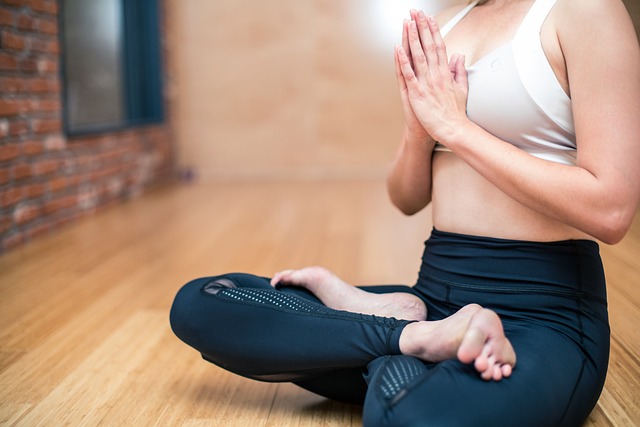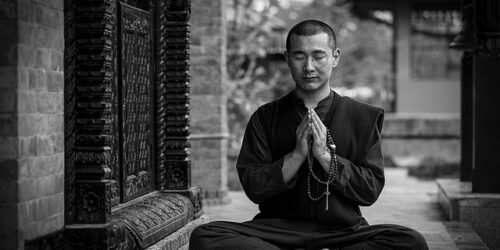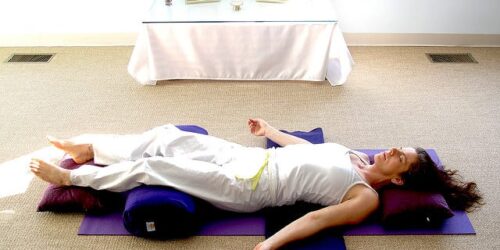Yoga and Meditation: the Differences & Which One is Better for You?
Yoga and meditation are often confused by the public. They resemble one another in comparison, but they are not the same thing. Between these two methods, there are a number of significant differences.
The yoga way of life includes meditation. While yoga focuses on both physical and mental exercise, meditation aims to achieve mental stability. While meditation is about concentration, yoga focuses mostly on poses and breathing techniques.
You are likely to experience a number of improvements in your life if you decide to start practicing either meditation or yoga (or both). Find out what yoga and meditation are, as well as their advantages and dissimilarities, by reading on.
Table of Contents
What is Yoga?
Yoga is not a religion, to start. Yoga is a way of life that aims to eliminate hardships and suffering from life in order to achieve the highest spiritual goal, “Samadhi,” or self-realization or union with higher consciousness. Yoga includes a variety of practices and paths that aid in producing the desired outcomes. It is extremely regrettable that the commercial fitness industry is attempting to use yoga as a gimmick for monetary gains and sales purposes. While stretching is a part of yoga, it is not the only supplement to rigorous physical activity. Yoga encompasses much more than that; it is a way of life. It takes a wholistic approach to healthy living. Yoga promotes harmony between the mind, body, and spirit. It also enhances daily routines, fosters better interpersonal relationships, and tunes up all bodily systems, i.e. circulatory, respiratory, hormonal, digestive, excretory etc. Yoga promotes mental stability, emotional balance, and peace of mind.
Yoga improves daily exercise routines, postures, immunity, and energy levels significantly. It is quickly evolving into a preferred technique for daily stress relief and effective weight loss. Numerous variations of yoga are practiced by people all over the world, including classical or Ashtanga yoga, Jnana yoga, Hatha yoga, Raja yoga, Bhakti yoga, and many more.
The Yoga Institute is a pioneer in teaching and training Classical yoga or Ashtanga. The first four limbs of traditional yoga are Yama, Niyama, Asanas, and Pranayama (also known as Bhairanga Yoga or external yoga). Pratyahara, the fifth limb, is regarded as the link between external yoga and internal yoga. Dhyana, Samadhi, and Antaranga Yoga are its three components. The five Yamas are rules for personal conduct, the five Niyamas are rules for social behavior, the Yoga Asanas are positions for greater physical and mental stamina, flexibility, and strength, Pranayama is breath control, Pratyahara is the withholding of senses, Dharana is concentration, Dhyana is meditation, and Yoga Samadhi is the ultimate goal of meditation mastery. Samadhi is thought to be the pinnacle stage, where one achieves unification with the divine or higher reality.
For beginners, mild learners, or everyday householders, the Patanjali Yoga Sutra’s classical yoga or Ashtanga yoga is advised. However, it is strongly advised that you learn how to do yoga from certified and experienced yoga teachers before you begin practicing. The classical form of yoga is best for those who want to maintain good character and a healthy body, mind, and spirit. Yoga has a wide range of holistic advantages.
Get started by Is Yoga Demonic?
What is Meditation?
We lead a fast-paced life today, filled with numerous obligations, stress, and unexplained phobias. The way that we think and the things that we typically do throughout the day diverge significantly. However, when your thoughts and actions are perfectly in sync, you are completely focused at that precise moment and don’t experience any conflict or stress. You’ve made the decision to focus on the present. Additionally, you tend to feel happier and less worn out.
Exercises or physical activity are not part of the meditation practice. A person sits down and makes an effort to direct their body’s energies toward a specific object, sound, breath, etc. In essence, meditation is a component of yoga and is typically practiced after Yoga asana. Meditation is recommended after yoga asana sessions because the body is vibrating afterward and it helps you achieve mental and physical stability. By reducing overthinking and coordinating breath control, meditation improves the self-realization process and promotes overall wellbeing. In contrast to meditation, practicing yoga has some obvious limitations, such as some asanas must be done on an empty stomach and others cannot be done if you are experiencing health problems.
Yoga meditation involves a profound state of unity with the subject of contemplation rather than thinking. Meditation is a regular practice of intense concentration on an object, sound, visualization, the breath, or deep attention to increase present-moment awareness. This reduces stress and anxiety, stops overthinking, and encourages relaxation. Thus, regular meditation practice helps to develop the capacity for this kind of focus. The basis of Dharna, or brief meditation on one object, is the ability to focus the mind’s attention on a single object with effort. If the student is to advance to the challenging stage of Samadhi or liberation, this is an absolute necessity. So let’s use a straightforward analogy to understand the distinction between Dharna and Dhyana.
Dharna can be compared to focused attention on a specific object for a brief period of time, like the trickling of water from a closed tap.
However, if you pour honey from the jar, the stream continues uninterrupted, which is comparable to Dhyana, i.e. concentration for a long while with total focus.
Only a select few people are fortunate enough to achieve liberation in the Samadhi limb of Ashtanga yoga.
According to ancient texts, samadhi occurs when a yogi can maintain dhyana for a long time. During this time, the yogi’s consciousness is purified and raised to such a degree that the soul resembles a transparent jewel that fuses with the higher reality on every plane. It is a condition that cannot be described in words. Only a very small number of people achieve the Samadhi state, making it an extremely rare phenomenon.
Therefore, meditation is an advanced form of yoga, and Sage Patanjali’s Yoga Sutra contains a significant number of sutras on the subject.
Yoga and meditation should be practiced together for overall health benefits, but make sure that they are both done with the help of a qualified yoga instructor. The distinction between yoga and meditation is now quite obvious.
If you’ve ever looked up ways to reduce your stress, you’ve probably come across meditation and instructions on how to do it. Since meditation is usually associated with new age practices, it can bring about some questions: is meditation a sin?

What Are the Differences Between the Two Practices?
Although there are some differences between yoga and Buddhist mindfulness meditation, there is no denying the synergy and apparent similarity between the two disciplines. The quality of mindfulness is the capacity to keep one’s focus on a particular meditative object (such as, breath, mantra), with emphasis on returning to beneficial (versus negative) thoughts. In a more conventional setting, mindfulness can be exercised by sitting quietly for a predetermined amount of time with your eyes closed. It can also be practiced in a yoga class by concentrating on your breath and movement as you hold and change positions. Instead of fighting or attempting to block out unpleasant thoughts, emotions, or sensations, yoga mindfulness meditation encourages increased awareness of the present-moment experiences. By cultivating an attitude of curiosity and attention to ongoing reactions to emotions, thoughts, and feelings and ultimately minimizing suffering with increased clarity of reality, mindfulness meditation can assist the student in learning how to disengage from evaluative or critical thinking.
Yoga’s physical component (asana), which is essentially a form of mindfulness that supports connection with present moment experience while moving from one pose to the next or during long held poses, is one notable distinction between yoga and meditation. Additionally, the physical component of a yoga practice can help the student get rid of their pain, stiffness, and tension in their muscles. In addition, some people may not be able to practice sitting meditation due to severe psychological or physical problems; for those people, a physical asana practice that may incorporate mindfulness techniques is the key to finding relief from suffering.
Benefits of Yoga and Meditation
Basically, you can anticipate better health in many ways if you begin a routine that includes yoga and meditation. There are many benefits that come with both practices; they are as follows:
- Better spinal flexibility
- Better health of the bones, joints, and muscles
- Improvement in rheumatoid arthritis
- Improvement in headaches, migraines, and hangovers
- Better cardiovascular health
- Reduced severity or recovery from asthma
- Better digestion and metabolism
- Better and more restful sleep
- Better emotional health (more stable emotions, better stress management)
- Improvement in brain function (including memory, concentration, and mental clarity)
- Increased flexibility in the muscles and joints
- Higher self-esteem, leading to better self-care
- Improvement in overall health from a holistic perspectiv
Yoga Vs Meditation: What is Better for You?
Actually, it only matters if a training session meets your needs. Both have benefits, and from what we have said before we can see that they are closely related. Your goals are the main factor.
For instance, you might discover that meditation is more beneficial and will provide you with the solutions you are looking for if you want to work on your anxiety, stress, or any other mental burden. Faster outcomes are possible!
Yoga, on the other hand, might be the best option if you struggle with focus and find it difficult to picture yourself slowing down to meditate. Aside from that, you can combine mental and physical training. Doing yoga might help you prepare for meditation.
Why Yoga and Meditation Belong Together
Yoga has many benefits that have been based on scientific evidence, some of them are:
- It can help you decrease stress
- Helps improving heart health
- It may reduce depression
- Reduces chronic pain
- Enhances sleep quality
- Improves flexibility, balance, and strength
As you can see, choosing to practice yoga has a lot of advantages. But is meditation a form of yoga? Meditation is a component of yoga, as was previously stated, so you might experience similar advantages.
Here are some of the many good things that meditating can bring to your life:
- Fight age-related memory loss
- Control anxiety
- Increases your focus and attention
- Helps to fight addictions
- More control of pain
- Can decrease blood pressure
If you are interested in knowing more about all the benefits, here you can find the best practices and their benefits.
To sum up, both practices are very beneficial and it mainly depends on what you want to focus on and on what to improve from your life.
So why pick just one when you can have both?
Combine Yoga and Meditation Now
Now that you know the benefits and definitions of each practice, you might be thinking that both techniques could be more powerful when combining them. Considering that yoga includes meditation. We would be able to work on enhancing our mindfulness, focus, and understanding of our bodies.
Meditation allows you to unwind and become more aware of your body, allowing you to practice yoga while remaining calm and conscious of every movement.
But in addition to yoga and meditation, you should consider other variables that could have an impact. Following a healthy lifestyle is not only exercising, but you also have to eat healthily. You should be aware that not all of your problems will be resolved by meditation; sometimes it is better to seek out psychological assistance.





